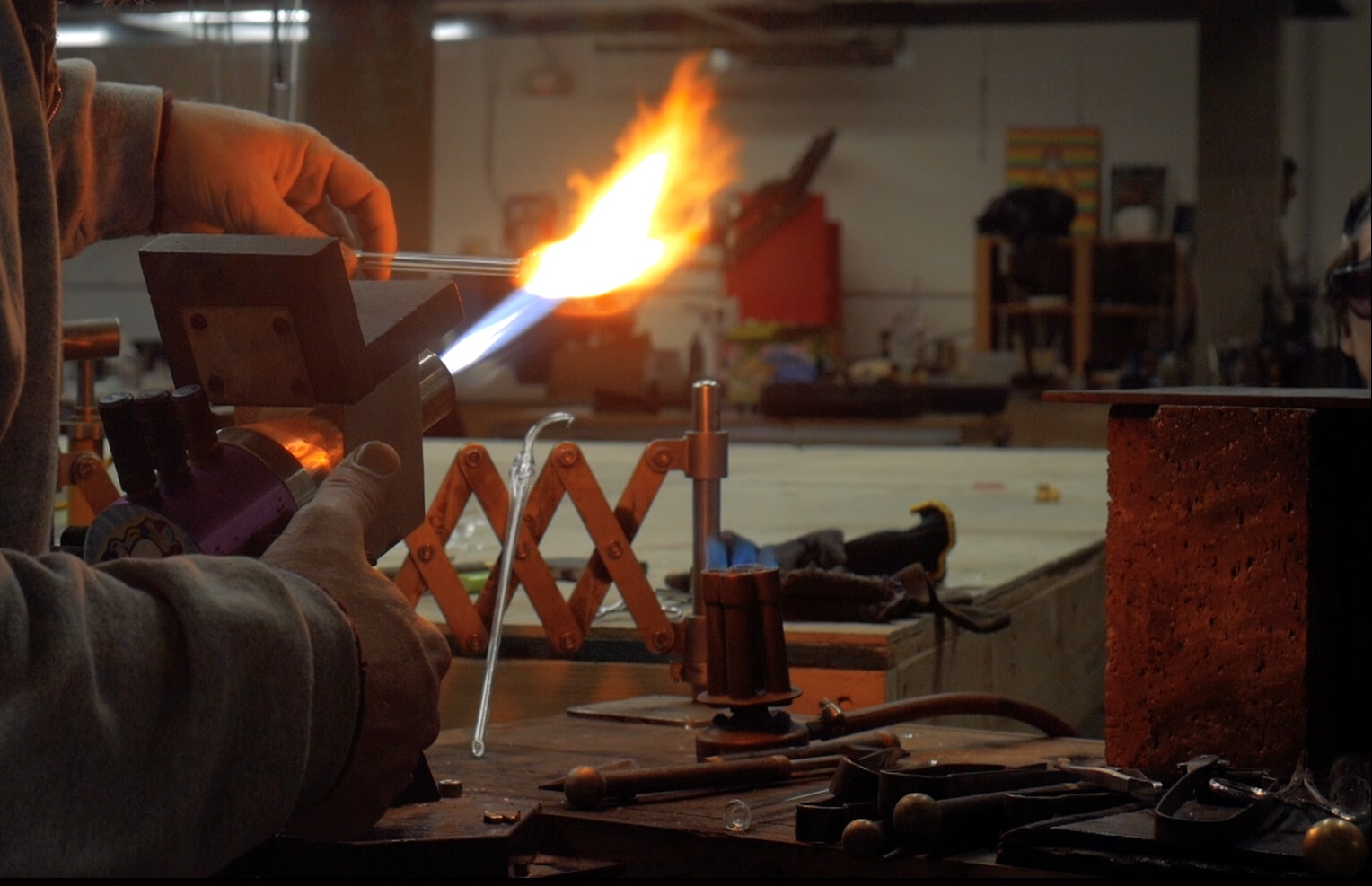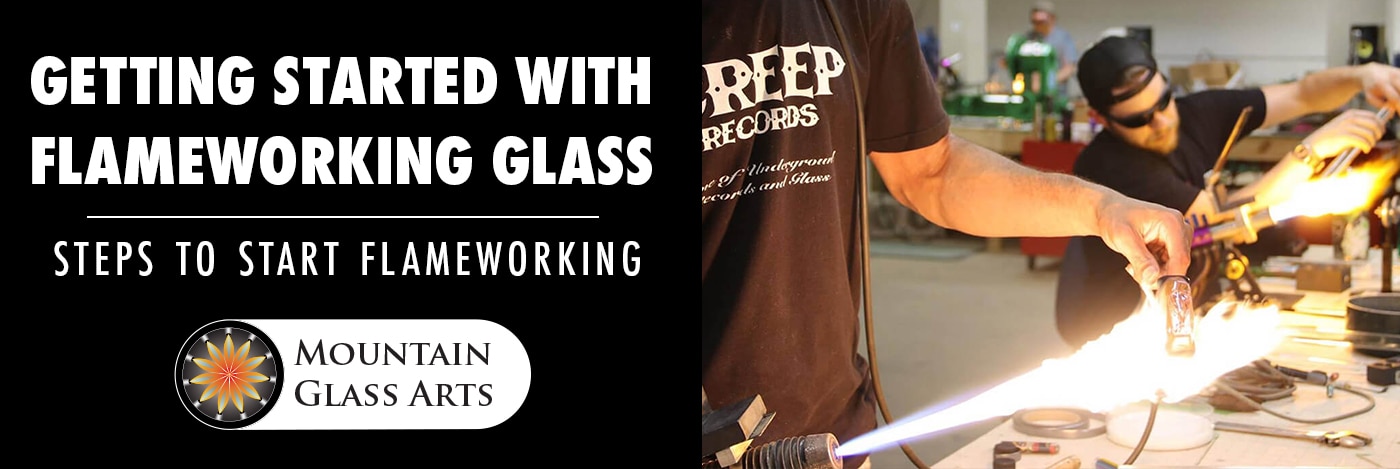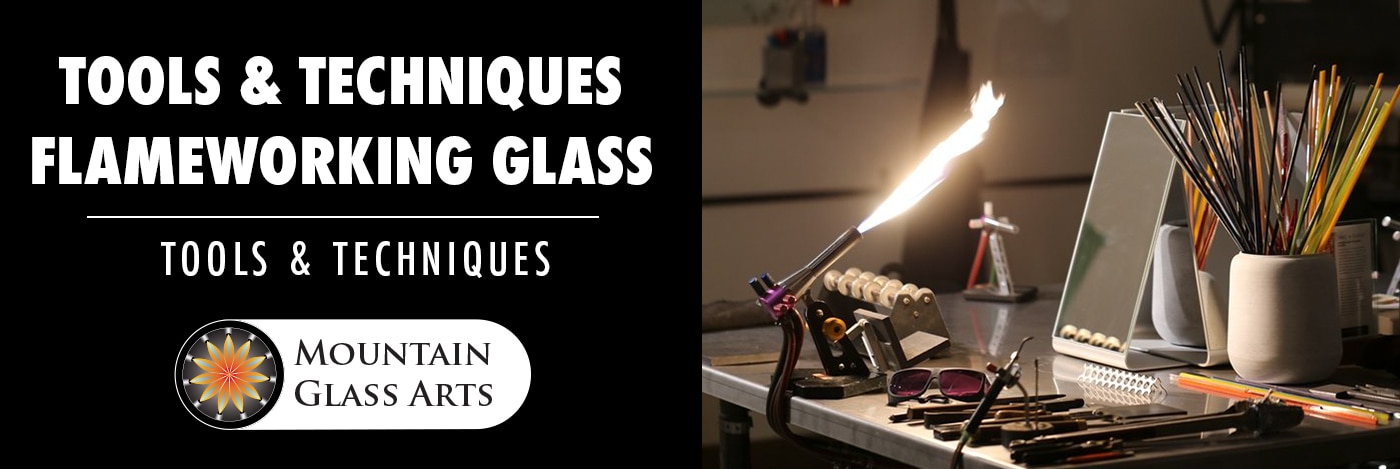Flameworking & Lampworking 101: A Guide to Torch Working with Borosilicate and Soft glass (2023)

Table of Contents
- I. What is Flameworking Glass?
- II. Getting Started with Flameworking Glass
- III. Safety Considerations in Flameworking Glass
- IV. Tools and Techniques Used in Flameworking Glass
- V. Common Techniques Used in Flameworking Glass
- VI. Popular Projects and Pieces in Flameworking Glass
- VII. Advanced Techniques in Flameworking Glass
- VIII. Troubleshooting Common Issues in Flameworking Glass
- IX. Additional Resources for Learning Flameworking Glass
If you've made it here then you most likely already had the joy of seeing flameworking or glass blowing in person or online. Or maybe you're admiring a piece of glass art and wondering 'how in the heck is this made?' Whether you're an aspiring flameworker or a curious learner, we will help you understand more about what flameworking is and how it is done.

What is Flameworking Glass?
Flameworking glass, also known as lampworking, is a type of glassblowing that uses a torch to melt, heat, and shape glass into whatever your imagination desires. Traditionally called lampworking, the art form dates back to ancient Roman and Egyptian times when people would use an oil lamp to melt the glass. It has since been modernized by using a torch commonly with oxygen and propane to create a flame. Natural gas in place of propane and/or hydrogen in place of oxygen are used in rare situations.
To create a flameworked piece, the artist first heats the glass rods and tubes with a torch until they become soft and pliable. Flameworkers and glass blowers use a variety of tools to make their work; tweezers, paddles, mashers, and most importantly their breathe, to shape and mold the glass pieces.
Once the piece is completed, it is placed in a kiln to anneal and eventually cool down. Depending on the size and complexity of the piece, this process can take anywhere from a few hours to several days.

Getting Started with Flameworking Glass
For those interested in learning how to flamework glass, there are a few key steps to getting started. Here are some tips for beginners:
- Take a class: The best way to learn the basics of flameworking glass is to take a class with an experienced instructor. These classes will cover the tools, techniques, and safety measures involved in flameworking glass, and will provide hands-on experience working with the torch and glass rods.
For those unable to visit physical locations to take classes, there are also online classes available that offer full video walkthroughs with flameworking glass instructors such as Revere Glass to learn glass blowing online. - Invest in quality tools and materials: To create high-quality pieces, you need to invest in good tools and materials. This includes a reliable torch, high-quality glass rods, and other essential tools. While it may be tempting to cut corners and save money on these items, it's important to remember that they are the foundation of your art, and investing in good ones will pay off in the long run. All of the equipment can be a little overwhelming, but we offer torch flameworking starter kits to simplify it and get your first torch lit up.
- Join a community:Join a local group or online forum to connect with other flameworkers and learn from their experiences. Flameworking glass can be a solitary pursuit, but there are many communities of artists who share tips, techniques, and inspiration.
- Revere Glass School - Glass blowing's most comprehensive online resource with Dustin Revere and guest artists.
- Zurich Glass School - Dr. Julie Anne Denton and guest artists offering an online school & learning community.
- Torch Talk - Providing comprehensive glassworking industry coverage, demonstrations and more
- Reddit Lampwork - Torch workers unite! From boro flamework to soft glass beads, we cover everything dealing with lampworking and flameworking.
- Practice, practice, practice: As with any art form, the key to mastering flameworking and glass blowing is practice. Spend time experimenting with different techniques and tools, and don't be afraid to make mistakes. The more you practice, the better you will become.
These are the most active and popular online communities and great places to start:

Safety Considerations in Flameworking Glass
Flameworking glass can be a fun and rewarding hobby or profession, but it is important to take safety precautions to avoid accidents and injuries. Safety tips to keep in mind when flameworking glass:
- Always wear protective gear when necessary: When working with a torch, it is essential to wear protective gear to protect your eyes, face, and hands from the heat and flame. This includes specialized safety glasses specifically for flameworking, proper clothing, and heat-resistant gloves.
- Work in a well-ventilated area: Flameworking and glass blowing produces fumes and smoke, so it is important to work in a well-ventilated area to avoid inhaling these harmful substances. Having proper ventilation is a must. With proper exhaust fans, a hood, good air intake, and ducting a safe working environment is easily achievable.
- Keep a fire extinguisher on hand: Accidents can happen, so it's important to always have a fire extinguisher on hand in case of an emergency. Be sure to regularly check that the extinguisher is in good working order and know how to use it properly.
- Be aware of your surroundings: When working with a torch, it is important to be aware of your surroundings and avoid potentially dangerous situations. This includes keeping flammable materials away from the flame, and not leaving the torch unattended while it is lit.

Tools and Techniques Used in Flameworking Glass
Flameworking glass requires a variety of tools and techniques to turn dreams into finished glass art. Some of the most common tools and techniques used in flameworking glass:
- Torch: The most important tool in flameworking glass is the torch. It heats the glass to be molten and workable. There are many types and styles of torches available.
- Glass: The raw materials used in flameworking glass. It is most often boroslicate glass , commonly known as Pyrex. Most flameworkers call it 'boro' for short. Borosilicate generally comes in color or clear. It generally is sold in rod, tube, and frit forms. It also has a large variety of colors and sizes.
- Tools: Once the glass is heated, the artist uses a variety of tools to shape and mold it into the desired form. These tools include tweezers, reamers, paddles, blowpipes, and the most important is your breath (blowing).
- Kiln: After the piece is finished, it goes into a kiln to anneal and cool. The temperature and duration of the firing process will vary depending on the size and complexity of the piece.
- Lathe: A machine that holds and spins glass in perfect rotation with a speed controller. A glass blowing lathe saves you the wear on your wrists and shoulders.
Common Techniques Used in Flameworking Glass
There are many different techniques used in flameworking glass, each with its own unique challenges and rewards. A few techniques used in flameworking glass:
- Gathering: The process of heating a glass rod or tube and using a blow tube to gather a hollow bubble or solid ball onto the end. This is used in most every moment of flameworking to make vases, bowls, sculptures, and really anything. Gathering requires a steady hand and good control of the blow tube and the use of gravity to control the shape of the glass.
- Marvering: A technique that involves using graphite or metal tools to physically shape the molten glass. Applying different colors of glass to the surface and then manipulating them with tools to create the desired design. Other than the actual blowing into the glass to shape it, this is the most popular technique for creating sculptures, pipes, beads, pendants, marbles, etc.
- Vacstack: A method for creating colored tubing using clear tubing and colored rod. Small tubing is nested inside of larger diameter tubing, and then color rod is fitted into the space between the two tubes. Once tightly packed, the entire assembly is connected to a vacuum pump, heated and spun until all the air is pulled out and the pieces have melted together into one single solid piece of clear jacketed color tubing.
- Encasing: Encasing is the process of surrounding a pre-made object with glass. This technique is used to create objects such as paperweights and figurines. Encasing requires careful planning and execution to ensure that the object is completely covered and sealed within the glass.
- Murrine: Murrine, or sometimes called millefiori, is a technique that involves creating intricate patterns in cross-section by stacking different colors of glass and then pulling them into long, thin rods. These rods are then sliced into cross-sections, revealing the pattern inside. Murrine is often used to create decorative elements in larger pieces.
- Latticino: Latticino is a technique that involves creating delicate, lace-like patterns in the glass using thin strands of glass. These strands are carefully arranged and then encased in clear glass to create the finished piece. Latticino is often used to create intricate pendants and other small pieces.
Popular Projects and Pieces in Flameworking Glass
Flameworking and glass blowing is used to make a wide variety of objects and pieces, ranging from small beads to pendants and large vases and to glass pipes. Some of the most popular projects and pieces in flameworking glass include:
- Beads: Beads are small, decorative objects that can be strung together to create jewelry or other decorative items. Flameworking glass beads are popular for their bright colors and intricate designs.
- Pendants: Pendants are small, decorative objects that can be worn around the neck on a chain or cord. Flameworked glass pendants are often created using techniques such as marbling, latticino, and murrine to create intricate designs and patterns.
- Paperweights: Paperweights are decorative objects used to hold down papers or other items. Flameworked glass paperweights are popular for their bright colors and unique designs.
- Figurines: Figurines are small, decorative objects that represent people, animals, or other objects. Flameworked glass figurines are often created by encasing pre-made objects in clear glass.
- Vases: Vases are decorative containers used to hold flowers or other objects. Flameworked glass vases are often created using the gathering technique to create larger pieces with intricate designs and patterns.
- Sculptures: Sculptures are decorative objects that represent people, animals, or other objects in three-dimensional form. Flameworked glass sculptures can be created using a variety of techniques, including gathering, encasing, and murrine.
Advanced Techniques in Flameworking Glass
Once you have mastered the basics of flameworking glass, there are many advanced techniques that you can explore to create more complex and intricate pieces . These techniques can be challenging to master, but they can also open up a world of new possibilities for your art. Some advanced techniques to consider in flameworking glass:
- Incorporating other materials: To add complexity and a uniqueness to your flameworked pieces, consider incorporating other materials into the glass. This can include adding inclusions such as gold or silver leaf, sand blasting, or including the glass with other mixed media.
- Multi-layer techniques: Another advanced technique in flameworking glass is creating multi-layer pieces. This involves building up layers of different colors and patterns to create complex and dynamic designs. This technique can be challenging, but the results can be stunning.
- Blending colors: Create unique and interesting pieces in flameworking glass by experimenting with blending different colors of glass. This can be achieved by heating two colors of glass together and then hand mixing them to create a blend.
- Working with different shapes: In addition to creating traditional round beads and pendants, advanced flameworkers can also experiment by assembling multiple pieces together into larger forms. One of the benefits of borosilicate glass is the ability to weld different sections together.
- Working with multiple torches: For larger or more complex pieces, some flameworkers may choose to use multiple torches simultaneously or jump back and forth between torches. This allows for more precise control and faster working times, but it can also be challenging to coordinate the movements of multiple torches.
Troubleshooting Common Issues in Flameworking Glass
Flameworking glass can be a challenging art form, and it is common to encounter problems or issues as you work. We all just say it is part of the job. Troubleshooting common issues in flameworking glass:
- If your glass is breaking or cracking, it is often because of improper heat base within all of the glass and/or improper annealing in the kiln. To prevent this, make sure you are heating the glass evenly and using the right tools and techniques to shape it properly. Just because something breaks or cracks does not mean it is not possible.
- If your glass is not staying in the desired shape, it may be due to the glass not being heated enough. To fix this, make sure you are heating the glass to the appropriate temperature for the desired shape and technique.
- If your glass is not melting to other pieces, it is likely due to not using enough heat or not applying enough pressure. To fix this, make sure you are heating the glass to the appropriate temperature and applying appropriate pressure when joining pieces together.
- If your glass is not releasing from or sticking to tools, it is usually because of overheating the glass. To prevent this, make sure you are touching your tools to glass that is not too hot or too cold. In some instances bee's wax or a releasing agent is used to prevent the glass from sticking to the tools.
Additional Resources for Learning Flameworking Glass
If you are interested in learning more about flameworking glass, there are many resources available to help you on your journey on our website. Some general resources to consider:
- Books: There are many books available on the subject of flameworking glass, which can provide in-depth information on techniques, tools, and safety considerations. We highly recommend the Contemporary Lampworking series by Bandhu Dunham.
- Online tutorials: There are also many online tutorials and videos available that can provide step-by-step instructions on how to flamework glass. Revere Glass Schooland Youtube page are a great resource for visual learners or those who prefer to learn at their own pace.
- Workshops and classes: For a more hands-on learning experience, consider taking a workshop or class with an experienced flameworker. These classes will provide you with the opportunity to learn from an expert and gain valuable hands-on experience working with the tools and techniques of flameworking glass.
- Community groups: Finally, consider joining a community group or forum for flameworkers. These groups can provide support, advice, and inspiration from other artists who are also learning and working in the field of flameworking glass.
If you're serious about pursuing flameworking or glass blowing as a career, there are a few key steps you can take to turn your passion into a profession. Tips for making a career with flameworking glass:
- Develop your skills: As with any career, the key to success in flameworking glass is to develop your skills and expertise. This means practicing regularly, trying new techniques and tools, and pushing yourself to create more complex and sophisticated pieces. The more skilled you become, the more likely you are to be in demand as an artist.
- Build a portfolio: A strong portfolio is essential for any artist, and this is especially true in the world of flameworking glass. As you create new pieces, be sure to document them with high-quality photos and descriptions. This will allow you to showcase your work to potential clients and galleries, and will give them a sense of your style and abilities.
- Market yourself: In order to succeed as a professional flameworking and glass blowing artist, you need to be proactive in marketing yourself and your work. This can include creating a website or online portfolio, attending craft shows and exhibitions, and networking with other artists and potential clients.
- Pricing your work: One of the challenges of being a professional artist is pricing your work. It's important to consider the time and materials that go into each piece, as well as the market value of similar pieces. It can be helpful to talk to other artists and galleries to get a sense of what is appropriate to charge for your work.
- Be persistent: Finally, remember that success as a professional artist takes time and persistence. Don't be discouraged if you don't see immediate results or if you face setbacks along the way. With dedication and hard work, you can turn your passion for flameworking glass into a successful career.
Building a career flameworked glass requires a combination of talent, skill, and dedication. By developing your skills, building a portfolio, marketing yourself, and being persistent, you can turn your passion for flameworking glass into a rewarding and fulfilling career.
One of the challenges of pursuing a career in flameworking glass is that it can be difficult to make a living solely from selling your art. In order to make a sustainable income, many artists need to supplement their income from other sources. Here are some ways that flameworking glass artists can earn a living:
- Teaching: Many flameworking glass artists find that teaching classes or workshops is a great way to supplement their income. This can be a rewarding experience, as it allows you to share your knowledge and skills with others who are interested in learning. Teaching can also be a good way to network and meet potential clients.
- Selling finished pieces: This can be done through galleries, craft shows, and online marketplaces. It's important to price your work appropriately and to create a strong portfolio to showcase your pieces.
- Commissioned work: Taking custom orders to push your boundaries and help make another person's dreams come to form.
- Other work: Finally, many flameworking glass artists need to supplement their income with other work, such as a part-time job or freelance work in a related field. This can provide a steady source of income while also allowing artists to continue working on their art in their free time.
Overall, making a living as a flameworking glass artist can be challenging, but it is possible. By diversifying your income streams and being open to new opportunities, you can earn a sustainable income while also pursuing your passion for flameworking glass.
In order to be successful as a professional flameworking glass artist, it's important to stay up-to-date with the latest trends and developments in the field. This can help you stay relevant and competitive, and can also inspire new ideas for your art. Staying current in the world of flameworking glass:
- Attend conferences and workshops: Conferences and workshops are great opportunities to learn from other artists and experts in the field. These events often feature presentations, demonstrations, and hands-on sessions that can provide valuable insights and inspiration.
- Join online forums and groups: Online forums and groups are a great way to connect with other flameworking glass artists and stay up-to-date on the latest developments in the field. Many of these groups also offer support, advice, and encouragement for artists at all levels of experience.
- Follow industry professionals and publications: There are many Instagram profiles that focus on flameworking glass and other glass art forms. These can provide valuable information on new techniques, tools, and trends, and can also highlight the work of other artists.
- Experiment and try new things: Finally, one of the best ways to stay current in flameworking glass is to experiment and try new things. This can mean working with new materials, using different techniques, or collaborating with other artists. By pushing yourself and trying new things, you can stay inspired and motivated in your art.
Any flameworker or glass blower will tell you learning the art form requires dedication, practice, and the right resources. Many flameworkers are self taught, but since flameworking techniques and materials are constantly evolving it is wise to expose yourself to as much opportunity as you can with a strong community and educational resources.
Overall, learning flameworking can be challenging, but can also be extremely rewarding. You often hear flameworkers say "we're like a moth to the flame", just drawn to the flame, the beauty of molten glass, and the joy of opening the kiln the next day to see your finished work.
Check out our video on Setting Up a 2-Inlet Torch